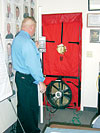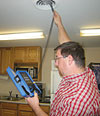
Dan McConnon from Halco conducts an air balance test, which is part of the company’s extensive energy audit process. (Photos courtesy of Duane Pancoast, The Pancoast Concern, Ltd.)
If the rising costs of energy over the last few years haven’t been enough to get your customers interested in finding ways to cut their utility bills, here’s something that might. President Obama would like to implement a cap-and-trade plan that includes cutting greenhouse gas emissions 83 percent below 2005 levels by 2050. Experts agree that this would result in significantly higher energy costs that will extend well into the future (see sidebar “What It Costs” below).
While higher utility bills may be a bane to your customers, they can definitely be a boon to your business - especially if you offer residential energy audits. These comprehensive home evaluation programs involve specially trained auditors assessing how much energy a home uses and offering suggestions for ways to improve efficiency. Not surprisingly, utilities across the country are offering energy audit opportunities to their customers, and many have partnered with Environmental Protection Agency’s (EPA’s) Energy Star, which provides guidance on how to evaluate new and existing homes for energy losses.
Energy audits offer contractors a golden opportunity to provide a beneficial service to customers, with the guarantee of not only being paid for the audit, but of securing more sales in the future (e.g., duct sealing, insulation, equipment replacement). Contractors should be forewarned, however, that it takes a serious investment in training and specialized tools before it’s possible to take on the mantle of home energy auditor. Indeed, most utilities and other state agencies require their partner contractors to undergo a substantial amount of training and testing before those contractors will be recommended to customers for energy auditing services.
The good news is, most contractors who have gone through the training and invested in the necessary tools say the outlay of time and money is definitely worth it.
TRAINING IS NECESSARY
Hal Smith, president, Halco Plumbing and Heating, Phelps, N.Y., first started offering home energy audits about three years ago. As a partner contractor with New York State Energy Research and Development Authority (NYSERDA), he had to obtain extensive training through the Building Performance Institute (BPI) before he could offer energy-auditing services.“Our people started with a six-day building analyst training course, followed by a test. Then there was a six-day course on building envelopes, followed by written and in-the-field testing,” said Smith. “Then there was a heating specialist course, cooling course, heat pump course, and mobile home specialist course. All followed by testing.”
And the training doesn’t stop there. Continuing education is necessary, said Smith, and the next step for his auditors is to become certified raters for the HERS (Home Energy Rating Service) program. He’s also taking an out-of-the-box approach by sending some of his auditors to a two-week course to become certified home inspectors.
“Our angle there is if we can get in front of a home buyer while they’re purchasing a home, we can test the HVAC system and show them options that could reduce their utility bills,” said Smith. “They’re arranging financing at that point, so why not roll those improvements into the mortgage.”
Matthew Holtkamp, president, Holtkamp Heating & A/C Inc., Buford, Ga., started performing energy audits in March of 2003 after initially obtaining training through Comfort Institute, Bellingham, Wash. As a preferred partner with Georgia Power, he was required to take more training classes through Southface Institute and BPI.

A blower door test, performed here by David Smith from Halco, is an essential part of a home energy audit, as it determines a home’s airtightness.
All that training has definitely paid off, as Holtkamp noted that energy audits have helped the business tremendously. “Our personnel are no longer stumped by building science issues, and when doing a blower door test during an estimate for a new HVAC system, we always come out as the expert, because no one else does that. If we do lose the job, pity the company that gets it, because the customer now knows what to expect.”
Smith agrees with the sentiment, noting that a blower door test is a minimum requirement before he’ll even take on a job. “That really separates out the customers who are just looking for a quick price. We never get those jobs anyway.”
Bob Brice, Energy Stewards International (ESI), Des Moines, Iowa, offers training courses through National Comfort Institute (NCI), and he agrees that energy auditing and performance-based contracting can be beneficial for contractors.
“There’s an unbelievable amount of work available to the contractor, if they want to get involved. Right now, the average heating and cooling system delivers 57 percent of its capacity, and that’s an average of new and old systems. The reason for that is everyone has been focused on equipment efficiency, and we’ve thrown out everything else associated with making a system actually work. Essentially HVAC contractors have allowed themselves to be turned into a commodity industry.”
Investing in training is the first step Brice suggests to those contractors looking to become involved in the area of analyzing and improving energy use in the home. “Most institutions do not train technicians on how to analyze installed system efficiency in the field. Much of the training available is sponsored by manufacturers, so it is primarily focused on the actual equipment. The training we recommend focuses on the entire system, including the duct system, installed efficiency, size, insulation, combustion efficiency, and proper airflow. Proper airflow is still the most misunderstood concept in the general HVAC community right now.”

Todd Martin of Halco measures the temperature of air coming out of the register. He will take the same reading of the air coming out of the furnace, so that he can calculate heat loss through the ductwork.
RETOOLING FOR PROFIT
In addition to extensive training, special tools are needed to perform comprehensive energy audits (see sidebar “Tools That Help” below). Smith said that the “must haves” include a blower door, smoke stick, and Duct Blaster, as well as more commonly used tools such as combustion analyzers, electronic gas/leak detectors, carbon monoxide testers, and electronic temperature/wet bulb probes.“After you get started, you will want to graduate to the next step and buy a thermal imaging camera and more expensive tools,” said Smith. “The camera is a great investment, but it’s not really necessary to get started with the program. You won’t be in it for very long, though, before you’re going to want to get one.”
All these tools are needed, because conducting whole house energy audits requires a lot of different testing. Holtkamp follows the guidelines offered by Energy Star’s “Home Performance with Energy Star” protocol, which includes inspecting the heating and cooling equipment, duct systems, appliances, attics/basements/crawlspaces, and running diagnostic tests to check the home’s envelope and duct leakage.
Holtkamp estimates his company performs 16 energy audits a month and that the audits and resulting home performance work account for about 25 percent of his annual sales. “The audits take about three hours to perform, and we charge $400 for the first HVAC system and $150 for the second.”
Smith offers several different levels of energy auditing services, starting with a free home energy visit. During that visit, a comfort advisor takes a quick look at the home and performs a preliminary blower test to determine whether a more comprehensive audit should be recommended. If so, the customer can choose from a one-half day audit for $350 or a more comprehensive full-day audit for $750. Oftentimes, NYSERDA underwrites all or some of the cost of the audit, and Smith deducts the cost from any additional work he is contracted to perform.
“We perform about 30 audits a month, and probably more than half of those are full-day, comprehensive audits,” said Smith. “Once we get to the point where we’re performing the audit, we have better than a 75 percent closing rate on additional work. The audits are definitely becoming a larger part of our business.”
While contractors can certainly benefit from offering energy audits, customers also reap the rewards. Dave Thompson, residential account representative, Austin Utilities, Austin, Minn., noted that in the several years since the utility started urging its 12,000 customers to partake in its energy auditing program, participating homeowners have saved 379 kW, 576,358 kWh, 1,575,950 gallons of water, and 50,872 CCF of gas. The utility also offers rebates for energy-efficient improvements, and in 2008, Thompson noted they paid over $127,599 to those taking advantage of the utility’s Conserve and Save Rebate program.
“Offering energy audits is ideal for HVAC contractors,” said Thompson, who added the utility uses a third-party auditor to conduct their energy audits. “It goes hand-in-hand with their business, because heating and cooling provide some of the biggest savings opportunities out there. On the utility side, we see results every time someone takes advantage of the program.”
Smith is glad he jumped into the energy auditing business, noting that it has increased sales while ultimately benefiting his customers. “It has required a huge investment in training and tools on our part, but what’s great about our business is that these services ultimately help our customers long-term. It’s a worthwhile investment and certainly the best thing for the customer.”
Sidebar: What It Costs
Under a cap-and-trade plan, the government would establish emission caps - basically maximum limits - on greenhouse gases, such as carbon dioxide. Fossil fuel power plants would be allowed to emit a certain amount of carbon dioxide, but anything over that limit would require them to purchase credits equal to the amount of carbon dioxide emissions they produced (e.g., one credit would represent one ton of carbon dioxide). The cost of those credits would be passed along to consumers, who could expect to see an increase in their energy bills.Just how much consumers could expect to see their utility bills increase has been up for debate, but a new report offers insight into this issue. The George C. Marshall Institute (www.marshall.org) recently released The Cost of Climate Regulation for American Households, which documents the economic burdens a cap-and-trade program to control greenhouse gas emissions will impose on American households. Authored by Bryan Buckley and Sergey Mityakov of Clemson University, the study states the following:
“Cap-and-trade will impact the prices households pay for electricity. Electricity prices are predicted to increase much more than gasoline prices. Lieberman-Warner’s cap-and-trade system is estimated to increase the price of electricity by anywhere from 5 to 15 percent in 2015 and anywhere from 14 percent in the EPA core scenario to 128 percent in the ACCF/NAM’s high cost scenario in 2030.
“We find that a mitigation path consistent with Lieberman-Warner’s provisions is equivalent to a permanent tax increase for the average American household. This cap-and-trade “tax” increases over time in real terms from about $1,400 to $2,000 during 2015-2030 and approximately $2,000 to $3,000 in 2030-2050.”
Sidebar: Tools That Help
Hal Smith of Halco Plumbing and Heating lists the following tools that contractors should consider obtaining before performing energy audits:• Blower doors
• Digital manometers
• Smoke sticks
• Hot wire anemometers
• Point and shoot thermometers
• Duct Blasters
• Thermal imaging cameras
• Flow hoods
• VANE barometers
• Electronic temperature/wet bulb probes
• Electronic carbon monoxide detectors
• Digital thermometers
• Electronic gas leak detectors
• Four-way refrigerant gauges
• Appliance watt meters
• Combustion analyzers
• Energy evaluation software
• Superheat and subcooling charts
• IAQ electronic analyzers
Publication date:06/01/2009


Report Abusive Comment